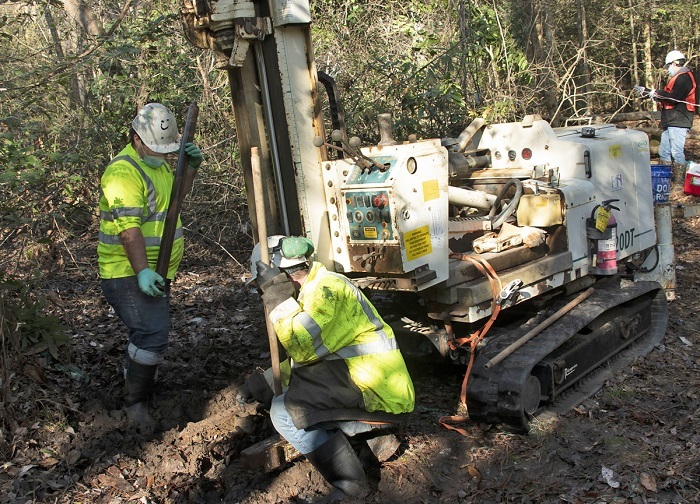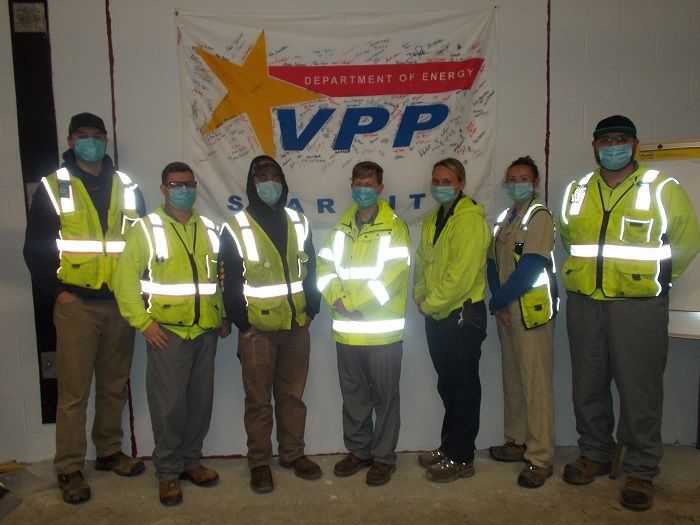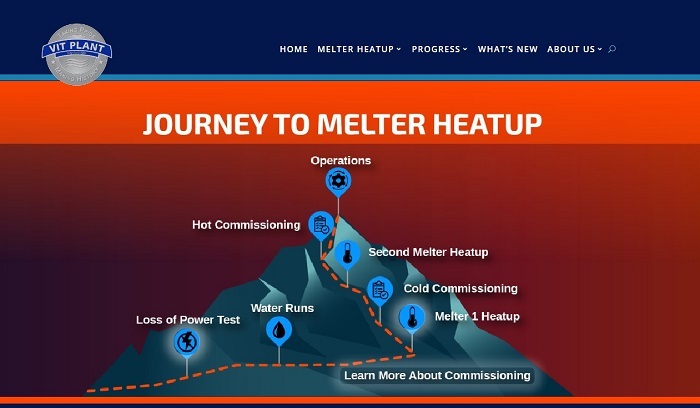 Savannah River Nuclear Solutions subcontractors drill for soil samples as part of a project to immobilize iodine-129 in the groundwater and soil at the Savannah River Site. Pictured are Donald Miles and Richard Mooney with Cascade Drilling Company.
AIKEN, S.C. – An EM cleanup technology is expected to reduce radioactive iodine-129 found in soil and groundwater near the center of the Savannah River Site (SRS) to levels well below regulatory limits.
Since 2019, EM’s environmental cleanup program at SRS has used an innovative process developed by EM contractor Savannah River Nuclear Solutions (SRNS) that uses silver chloride, a conventional industrial product, to immobilize iodine-129. The cleanup technology does not generate waste and requires no power.
Extensive studies confirm that injecting silver chloride beneath a portion of the site reduced up to 50% of iodine-129 during pilot program field tests.
“The silver can capture and lock into place a high percentage of the iodine nuclides, reducing the amount of contamination in the groundwater,” SRNS Area Cleanup Projects Engineer Jeff Thibault said.
Ultra-fine particles of silver chloride are specially milled by an off-site vendor to create highly irregular edges, which greatly increases the surface area of the particles. The material is mixed with water and injected into the water table 30 to 60 feet below the surface. Workers have injected a total of 240,000 gallons of water and 165 gallons of silver chloride.
At SRS, iodine-129 was created during the production of plutonium and tritium throughout the Cold War era.
Working with Savannah River National Laboratory (SRNL) scientists, SRNS is striving to prevent the remaining iodine-129 from moving into nearby wetlands in large quantities.
Current treatment relies on chemicals, such as silver chloride, and soil to work together to bind the iodine to sub-surface sediment, prior to it reaching the wetlands.
“Once this plume fully enters the marsh, treatment, much less immobilization of the iodine, becomes much more difficult,” Thibault said. “There’s no sediment. We’ve gone from mud-like sediment to working with organic material and the water of the marsh.”
SRNL Geochemist Hansell Gonzalez-Raymat said workers have completed shallow drilling for soil samples in the affected wetlands.
“The data collected from the samples will help us to determine how the iodine will interact with the organic matter and surface water found within SRS wetlands. This research will lead to the future development of a strategic treatment plan that can be submitted to the South Carolina Department of Health and Environmental Control for approval,” he said. “This is part of a larger project within the site’s F Area that is partially funded by the EM Office of Technology Development.”
Thibault said SRNS is working to make the project “passive,” requiring minimal maintenance and use of little to no electrical energy.
“We are looking at the possible use of silver chloride, along with other cleanup technologies, to continue the level of success we’ve experienced in the past. We are confident we’ll protect our wetlands,” he said.
-Contributor: DT Townsend

EM senior representatives recently met with officials from United Kingdom cleanup organizations for an annual meeting where they focused on the U.K. Nuclear Decommissioning Authority’s (NDA) approach to sustainability and working with DOE to develop critical metrics to demonstrate success.
“EM highly values international cooperation and we are eager to work with organizations in the U.K. to share information and lessons learned from an environmental program comparable in size and complexity to our own,” said Mary Kruger, EM’s director for regulatory, intergovernmental, and stakeholder engagement. “I look forward to many more opportunities to further our cooperation in addressing common cleanup challenges.”
EM hosted the 18th Annual Standing Committee Meeting with colleagues from the NDA and National Nuclear Laboratory. The standing committee reviews accomplishments from the past year and identifies areas of focus and new priorities to help address challenges in the U.S. and U.K. cleanup programs.
The meeting provided an opportunity for Acting EM Assistant Secretary William “Ike” White to meet with NDA CEO David Peattie. White and Peattie shared updates from both countries’ cleanup programs.
Meeting participants confirmed that an area of keen interest is project peer reviews to enable the transfer of knowledge and lessons learned between the organizations, and help develop professional relationships that will endure into the future.
They also identified topics to consider for future discussion, including cybersecurity, risk-based decision-making, stakeholder engagement, near-surface disposal facility planning and operation, knowledge transfer and workforce development, and artificial intelligence and machine learning.
-Contributor: Rosa Elmetti
|
 The West Valley Demonstration Project Surveillance and Maintenance Crew is responsible for site maintenance, which includes everything from cleaning and sanitizing to landscaping and snow removal. From left are crew members Jordan Wonderling, Cody Welch, Derek Wells, Jessica Schiedel, Jennifer Kessler, Sarene VanName, and Jeff Zygaj. Crew members Dennis Sullivan and Taylor Weyand are not pictured.
WEST VALLEY, N.Y. – A typical day for the surveillance and maintenance crew at EM’s West Valley Demonstration Project (WVDP) might begin with cleaning and sanitizing common areas and end with fixing a door, moving offices, changing a light bulb, or operating a tractor.
The team’s main responsibility is to sanitize common spaces like breakrooms, and deep clean target areas to help protect colleagues from the spread of COVID-19. The site also purchased new sanitizers, including the handheld variety, for better protection of the workforce.
“The work this team does helps keep everyone safe and allows us to continue our cleanup mission,” said Dave Smith, surveillance and maintenance manager for WVDP cleanup contractor CH2M HILL BWXT West Valley (CHBWV). “I’m proud to work with this team of dedicated men and women who continue to prove that every action taken, whether big or small, can have a huge impact on people’s lives.”
The crew also performs site maintenance, landscaping, and snow and trash removal.
“What we do allows everyone to come to work safely and go home to their families at the end of the day,” team member Dennis Sullivan said. “It’s a great feeling to know that what you do does make a difference.”
Crew member Jennifer Kessler noted that the variety of tasks keeps work interesting.
“Not only do we wear a different hat four days a week, but we can also wear multiple hats each day,” Kessler said. “Everything we do has a positive impact on the WVDP team as well as the site. That’s what motivates us.”
The crew accomplishes most of its tasks when employees are not in their offices or at work sites.
“It is the work performed behind the scenes that makes sure the trash cans are empty, broken light bulbs are changed, and areas are cleaned and sanitized,” Smith said.
-Contributor: Joseph Pillittere
 Click here for Hanford’s new melter “heatup” website.
RICHLAND, Wash. – As the EM Hanford Waste Treatment and Immobilization Plant (WTP) team moves closer to starting up the first of two melters inside the Low-Activity Waste (LAW) Facility, plant contractor Bechtel National, Inc. (BNI) has launched a website that explains the WTP commissioning process, including critical activities such as the loss-of-power test and the melter heatup process.
“We want our key stakeholders and local community to understand the steps being taken to ensure a safe, quality, and effective heatup of the first melter,” said Mat Irwin, Office of River Protection deputy assistant manager for the plant. “We are approaching a 24/7 operational situation at a pace not seen at the Hanford Site in many years. We’re excited to deliver on this commitment to our community.”
The two 300-ton waste melters will heat Hanford’s low-activity tank waste and glass-forming materials to 2,100 degrees Fahrenheit, vitrifying it for safe disposal. Vitrifying means immobilizing the waste and materials within a glass form. The loss-of-power test will demonstrate the team is able to protect the melter by putting the LAW Facility into safe condition and restoring power before any damage to the melter occurs.
The Journey to Melter Heatup website includes information such as:
- The many activities that must be completed to enable melter heatup, such as installing key equipment and tuning the exhaust system.
- Common melter heatup terminology definitions.
- Key facts such as how many days it takes to bring the melter up to target temperature.
- The latest news on progress toward heatup.
For example, initial heatup of the melter takes about 22 days, followed by several days of testing with the addition of glass startup materials that melt at low temperatures, and then another 30 days of feeding in glass-forming material.
Melter heatup will culminate the progress toward starting Direct-Feed Low-Activity Waste (DFLAW) treatment by the end of 2023. DFLAW is a system of interdependent projects and infrastructure improvements, managed and highly integrated as a program, that must operate together to vitrify low-activity waste.
-Contributor: Staci West
|